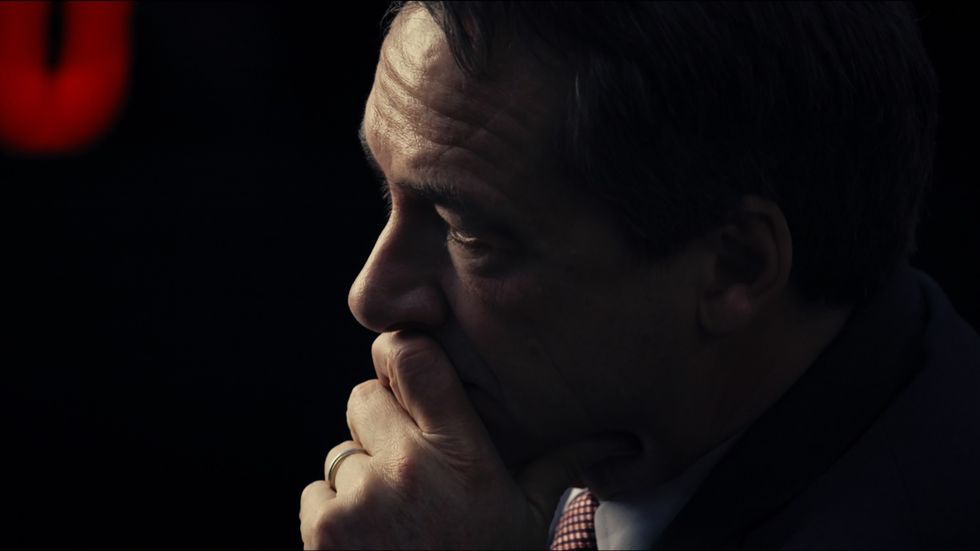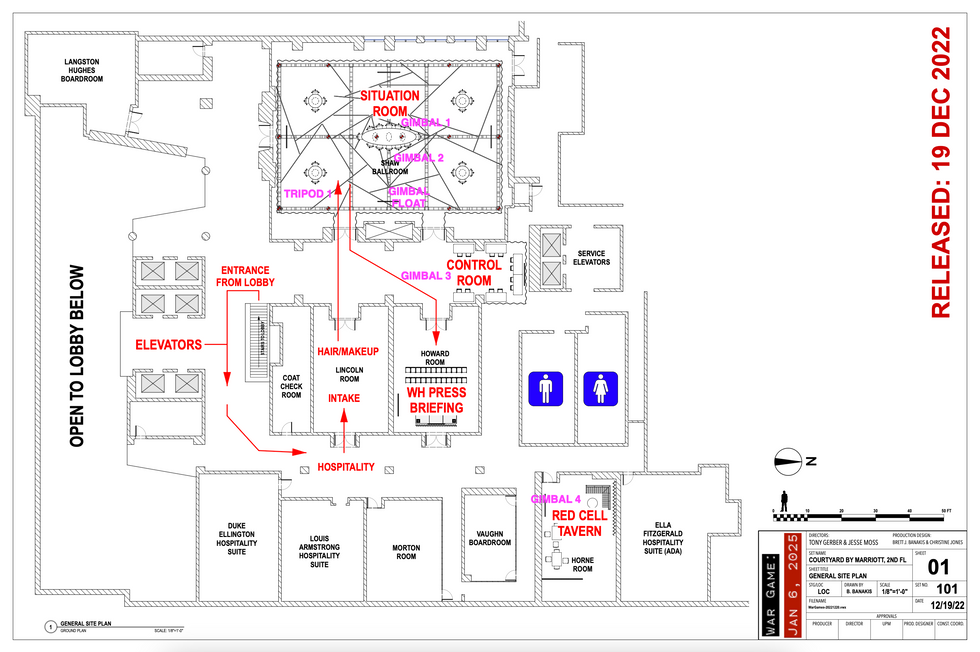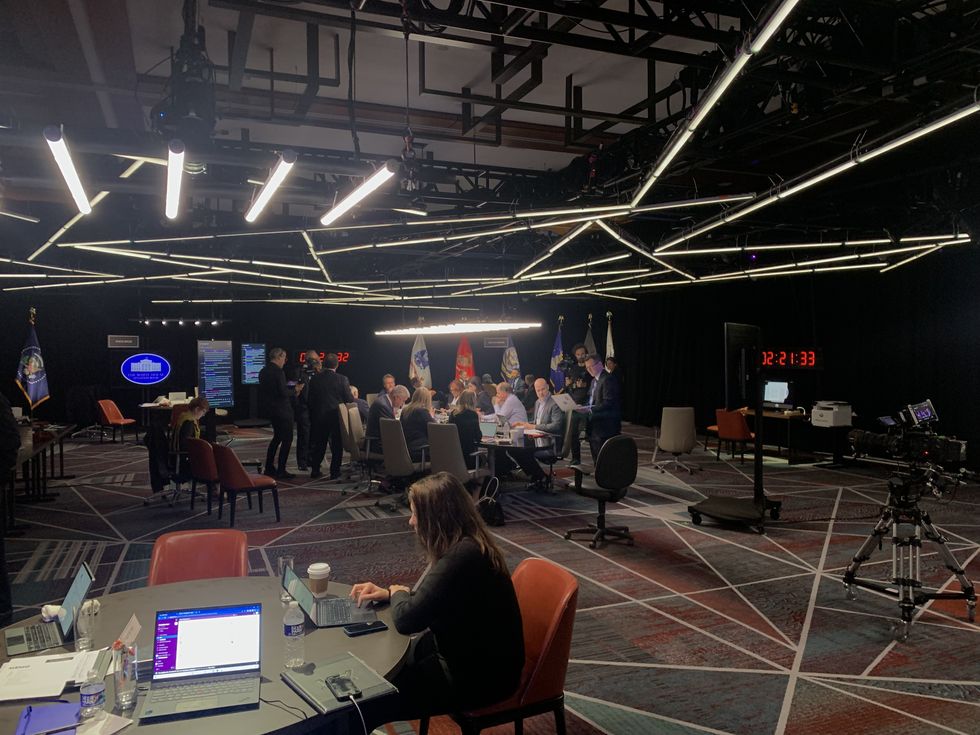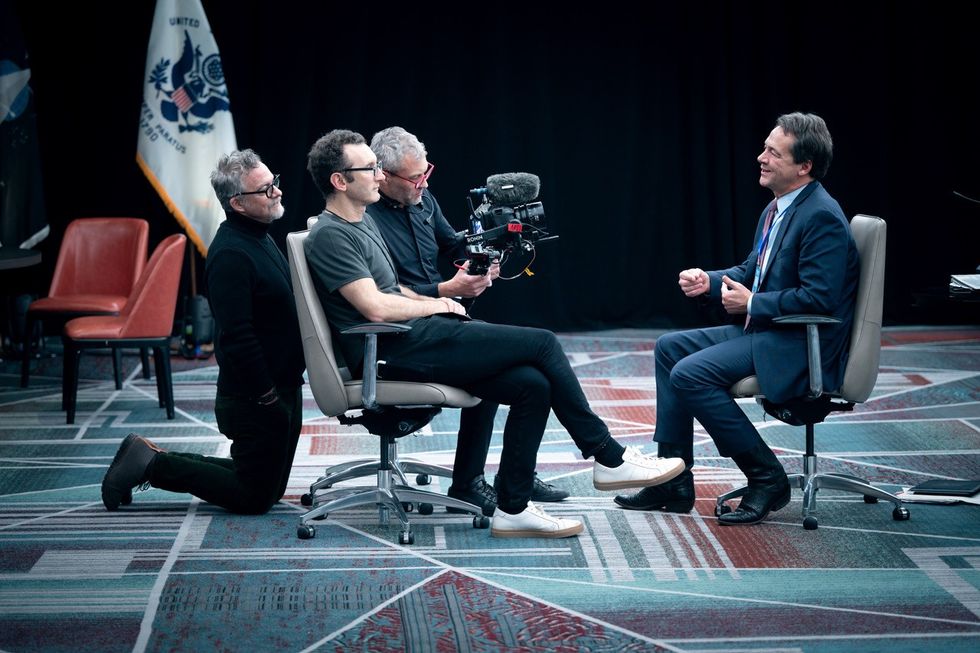
How would you shoot a live, high-stakes political event, happening over six hours, in one try?
This was the task given to the production team of War Game, a documentary following a simulated insurrection much like the one that happened on Jan. 6. Filmmakers Jesse Moss and Tony Gerber observe the role-players tasked with plotting a response during the single-day exercise, all while disinformation rages and the imagined stakes keep rising. It’s a tense and stark look at the current state of American politics.
Cinematographers Thorsten Thielow and Wolfgang Held led the team in filming the unscripted event. It required creative solutions to coverage with the use of seven cameras and operators constantly dancing out of each other’s way to achieve as much immersion as possible.
No Film School caught up with Held after the film’s Sundance screenings for a Zoom chat about how they planned the day, the challenges of the shoot, and more.
Achieving the Look

Held said he and Thielow referenced several projects as visual inspiration, including Seven, The Matrix, Children of Men, and The Joker. The camera operators included Thielow, the lead DP, on a gimbal, focusing on the president’s main table. Held was co-lead DP on a 50-1000mm Canon zoom on a rolling tripod.
“Thorsten had started with shooting a lot with a Canon C70, which is a relatively small camera that looks like a DSLR camera because he shoots a lot on the Ronin S-II at the time, a small gimbal, and using a small moving camera and a gimbal, that was the main tool he used before we started shooting,” Held said. “The plan was to have many, many cameras come together during the shoot … I think it was seven cameras shooting. And to use the gimbal as the main tool, both to have cinematic moves between the different rooms of where this activity was taking place.”
Held’s idea was to balance the cinematic shots with close-ups.
“I wanted to have these super tight close-ups of faces to balance the wider shots that are moving around the people,” Held said. “So I brought in the idea of using a Canon 50 to 1000 millimeter lens, which is a very telephoto lens, to balance out all the wider gimbal shots and have this super tight, especially on the president and the people around him. So I was hiding in the dark corner, dressed in black and nobody else’s shots with a super long lens.”
Daniel Carter was cross-shooting with Thielow on a gimbal on the main table, the press room, and other locations. Tim Grucza used a gimbal in the “red cell” or enemy room. Brett Wiley was on a gimbal in the control room, hallways, and all around. Keri Oberly shot on a Canon 100-400 mm zoom on a rolling tripod.
Altogether, the project included four Canon C70 on Ronin S2s gimbals with Canon Cinema Prime lenses, two Canon C500 MK2s for Canon 50-1000 mm and Canon 100-400 mm zooms.
Coordinating Multiple Cameras

Held shared the above plan for movement and placement on the day of the shoot, which required an immense level of detail and coordination. Camera operators are rarely seen in any of the shots, despite being nearly on top of each other in limited spaces.
“Yeah, that was sort of the idea with having one person stay in the red cell room because they were in a separate room,” Held said. “They never really ventured out much from the room, which was also on the same floor in the corner. And then the people were drifting in the control room … Daniel and Thorsten were circling the table, and they have done this dance before, as have I, with Thorsten and Daniel to stay out of each other’s way. So, I think they were using 35 millimeter lenses in full frame. So they had pretty wide lenses, but they knew where to be when one person was shooting; the other person wouldn’t go on the other side. They would three-quarter cross-shoot, and knew where the actual frame was, and found matching shots on the other side.
“So I believe there were never more than two gimbals around the table. And then with the two long lenses that were almost in the corner behind them, and sometimes it’s obscured, and sometimes the cameraman goes through it, but it’s so long lens, you would never know it. And we all wore stage black, so we’re less visible. And I think it worked out pretty well.”
As mentioned, the goal was immersion.
“The idea was to make this feel like you’re in the room, you get the president and the pressure building with the tight class shots, and you have this freedom of the movement to go everywhere and get the sense of the interaction within the different elements of the game and give energy with the movement of the camera.”
Lighting the War Room

The DPs were also tasked with figuring out how to light the location, which presented some unique challenges. They were in what Held called a “1980s windowless large ballroom in a hotel” along with a few side offices, all dressed to look like parts of the White House.
“Tony Gerber, I think, came up with the idea of having a lighting that mimics the carpet with irregular white fluorescent lights hanging in the ceilings above the carpet,” Held said. “And we were trying out different scenarios in the pre-light day before. I think Thorsten and I came up with the idea of building also to light the people. The idea was to maybe use this pattern of these white lights in the ceiling and then put soft lights over them to light the table. And Thorsten and I both felt that that would get too messy. We wanted to light the people with those white fluorescent lights that you actually see in a lot of the shots.”
They build a lighting rig to hang low and mimic the pattern of the room’s carpet.
“The light was low enough, so it was both the set and lighting the people. So we found a way to do both with the same simple lighting approach. And then there was a color coding depending on where they were in the game, where the lights were either white or red.”
Held’s Advice to Cinematographers

Held acknowledged the benefits of going to film school, or simply finding a cinematographer you admire and going to work for them.
“The last advice that I give to people a lot is to start in a rental house, the camera rental house,” he said. “Because if you don’t want to do the whole film school route or even after, it could be a way to meet camera people who are coming in … I’ve seen many, many people who worked in a rental house very quickly getting into very good assistant camera positions because they know the equipment well and they meet a lot of camera people very simply.”
And what should DPs know about shooting documentary work?
“Well, I mean, it depends so much on the film, right?” Held said. “For me—I do both narrative and documentary—and to me, good documentaries are almost like fiction in that they have people like Thorsten and Jesse looking at other films, making moodboards, coming up with ideas. Doesn’t happen that much in documentary, unfortunately… There’s so many ways to give them a cinematic feeling. To look at other films that inspired you or come up with concepts and ideas.”
Held suggests that all films should “have a strong idea of what they want to do before they start.”
“So, it depends a little bit on what the film is, and then choosing the right palette and lenses and movement to that, and look at films that inspire you and study [them]. What lenses did they use? What colors do they have? How long are the shots? Is it a very fast cut, or is it like super long takes that never cut? And all these things you can carry into your own films. And that’s true for both documentary and fiction.”

No Film School’s coverage of Sundance 2024 is brought to you by Canon.
Author: Jo Light
This article comes from No Film School and can be read on the original site.
